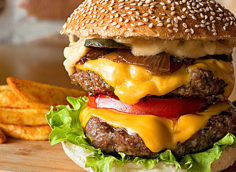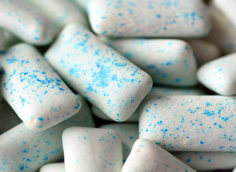The Real He-Who-Must-Not-Be Named
Cancer is the true monster of modern times, the real Lord Voldemort, only, unlike He-Who-Must-Not-Be-Named, people speak the word cancer all the time, so much so that we can't get through a single day without hearing that someone we know has it or might have it, or that something we love doing or eating causes it.
It's only natural that most of us have grown to be paranoid about cancer. Personally, I knew my paranoia had grown to extreme and messed up dimensions when one day a few years ago, while driving, I laid my right hand against my lap and felt a large, soft lump.
Within milliseconds, panic set in and I imagined a positive biopsy, months of painful and debilitating chemo, and an ignoble death in some hospice.
Luckily, the lump turned out to be the smooshed-up Mounds Bar I'd jammed in my pocket a few hours earlier, but the speed at which I'd jumped to my ridiculous conclusion convinced me that I needed to do something about my paranoia. I set out to know this horrible enemy and come up with a preventative nutritional/lifestyle plan.
The result was a series of "weapons" against cancer, each based on science, research, deductive reasoning, and maybe a little bit of wishful thinking. There aren't any guarantees it'll actually save me from cancer, but I've got a good degree of faith that it'll help.
So, for my fellow paranoiacs, here are my anti-cancer weapons. The good news is that, based on the fact that you're on this site, you're already doing something that's hugely protective against cancer, and that's the first weapon.

Men who lift weights, and who have a high degree of muscular strength, have a 40% lower risk of dying from cancer. Similarly, men who have weaker handgrip strength have an increased risk of cancer. Exercise in general helps women fight breast cancer.
Recently, Jeroen van Vugt, a graduate student in Rotterdam, examined the patient profiles of 206 people with an aggressive type of colon cancer. All of them had undergone surgery and 44% of them lost enough weight to be diagnosed with sarcopenia, a degenerative loss of muscle mass (1).
Patients in this group were more prone to surgical complications and had additional surgeries 2.1 times more often than patients with a healthy amount of muscle mass.
Enthused by what he had discovered, van Vugt then followed another group of 816 colorectal cancer patients from whom doctors had removed affected organs. What van Vugt found was that people with more muscular density died less frequently than those with low muscle density.
There's a lot more positive research, too. Suffice it to say that the evidence that strength training prevents you from dying prematurely from cancer or anything else is overwhelming.
Whether it does this by increasing insulin sensitivity, reducing body fat, causing the release of the myokine IL-6 (which fights inflammation), or stimulating AMPK production (which starves cancer cells), isn't known for sure, but all those effects probably play a role. The message, of course, is this: Keep pumping.

Chinese epidemiologists, after scanning ten epidemiological studies, found a stunning correlation between eating carrots and the rate of prostate cancer (2).
They found that the more often men ate carrots, and the greater the amount of carrots eaten, the less likely they were to get prostate cancer. They even came up with some definitive numbers: For every 10 grams of carrots consumed each day, men reduced their risk of developing prostate cancer by 5%.
That means that if men had at least 50 grams of carrots a day, their chances of developing prostate cancer could be cut in half. The researchers think it has something to do with the large amount of cancer-fighting carotenoids found in carrots.
The average carrot weighs about 72 grams, and a cup of chopped carrots weighs around 122 grams, so it's not like you have to eat a Bugs Bunny bushel-full of carrots to get to your 50-gram goal. Just one carrot a day should give you some protection against the most frightening of male maladies.

A really weird thing pops out at you if you start looking at epidemiological studies pertaining to mortality rates from health conditions like cancer, cardiovascular disease, and diabetes:
The farther you get from the equator, the higher the mortality rate from these diseases (3). Likewise, the survival rate of patients with the aforementioned diseases increases if the diagnosis was made in the summer months.
Figure it out yet? Increased distance from the equator and winter both equate to decreased exposure to sunlight, particularly the UV-B radiation that's needed for the synthesis of Vitamin D, a vital component of the immune system.
Unfortunately, only a few foods contain appreciable levels of vitamin D. These include salmon, cod liver oil, mushrooms, and to a lesser degree, egg yolks. Fortified dairy products contain it, too, but most people try to meet their vitamin D needs through supplements.
The problem, according to Michael F. Holick, PhD, MD, is that supplemental vitamin D isn't the same as the vitamin D produced by your skin when it's exposed to sunshine. This "natural mode" of vitamin D enters the blood a lot more slowly and lasts twice as long as supplemental vitamin D.
And while chronic sun exposure comes with its own host of problems, short-term, occasional sun exposure appears to be safe, along with prompting your body to make sufficient quantities of vitamin D to keep your immune system functioning well.
Just make sure you follow the "no sunburn (and no cancer) rule," which means lying in the sun about half the time it would take to develop sunburn.
For dark-skinned people, that should equate to about 30 minutes in the sun, while fair-skinned people should restrict their dosage of rays to about 10 minutes.
Of course, if it's winter, you've no choice but to use supplemental vitamin D, but it's tough to figure out exactly how much you'd need without a blood test and subsequent experimentation.
Generally speaking, you want blood levels of vitamin D to be well above 50 ng/ml (up to about 75), but again, you're not going to know that without a blood test. However, for the vast majority of people, taking 5,000 IU of vitamin D3 (the best absorbed form) a day will more than do the job.

Metformin, originally known as glucophage ("sugar eater"), is currently used by type II diabetics the world over to suppress glucose production by the liver. It also increases liver sensitivity, beefs up glucose uptake by tissues, and reduces insulin-induced suppression of fatty acid oxidation.
But forget about its sugar-eating ability and focus on its cancer-fighting ability. In one of the largest studies of its kind, a group of scientists pored over the 10-year case histories of 8,000 type II diabetics who'd been using metformin (4). They found that metformin users had an incredible 54% lower incidence of ALL cancers compared to the general population.
Not only did the drug exhibit a preventative effect, but metformin users who developed cancer had a much higher survival rate, including those with malignant tumors of the lung, colon, and breast. The earlier they started using metformin, the longer they continued to fight off cancer.
So why would a blood-sugar lowering drug protect against cancer? One reason is that it reduces obesity, which is a risk factor for more than a dozen cancers. (Generally, there's a 59% increase in the incidence of cancer for every 5-unit increase in body mass index, or BMI.)
Secondly, metformin increases the production of an enzyme known as adenosine monophosphate kinase, or AMPK, which in addition to being a fuel sensor and metabolic master switch, regulates cell growth and replication. It can literally tell cells to stop drawing energy. Once AMPK is activated, cancer cells end up starving themselves because the energy lifeline's been cut.
Fantastic, right? The trouble is, metformin has a downside. Users can develop a side effect called lactic acidosis, which can be fatal. Others just don't feel well while using the drug, and there's also some evidence to suggest it could interfere with muscle growth.
Luckily, there's a natural substitute that affects AMPK (and presumably cancer) the same way as metformin. It's called cyandin 3-glucoside (sold as Indigo-3G®) and it's a polyphenol found in dark colored fruits or berries. It also favorably partitions nutrients to muscle instead of fat, so it both fights cancer and buffs you up. More info here.

Science has managed to patch up the ozone layer a bit, but ultra violet rays are still assaulting our DNA and causing squamous cell carcinoma and actinic keratosis (a pre-cancerous skin condition). Use all the sunscreen you want, but unless you zinc oxide yourself up so you look like the fourth member of the Blue Man group, your skin-cell DNA is slowly being fricasseed by sunshine.
Plain old aspirin might be able to help, though. Sun-baked Australians, who take things like skin cancer personally, have found that people who used aspirin at least twice a week for five years saw their risk of skin cancer reduced by 60%, while those that had used it daily for at least 5 years saw a reduction of 90% (5). These benefits allegedly start to show up after as little as one year of use.
Furthermore, another study published in the journal Cancer found that 60,000 Caucasian women who had taken aspirin at least a couple of times a week were 20% less likely to develop melanoma, the deadliest form of skin cancer.
Likewise, aspirin seems to dramatically lower the incidence of colon cancer, which seems to be affecting Gen X'ers and millennials at disproportionate rates. "People born in 1990 now have double the risk of colon cancer and quadruple the risk of rectal cancer compared to people born around 1950," explained Rebecca Siegel, MPH, of the American Cancer Society.
Just take one or two baby aspirin every day to give yourself some added protection.

Research has shown that the main catechin in green tea, EGCG, prevents the proliferation of leukocytes, which are white blood cells that sometimes indicate the onset of skin cancer. Furthermore, EGCG also induces cancerous skin cells to perform apoptosis, which is a technical word for cell suicide (6).
That means that green tea appears to not only prevent sun damage, but may actually reverse it. It's also possible green tea, like aspirin, may even afford some protection against melanoma, the deadliest form of skin cancer (7).
Most experts think you need between 250 to 400 mg. of green tea extract (containing the four main green tea polyphenols) to possibly protect yourself against sun damage. You can get that from a cup of green tea, which contains an average of 253 mg. of catechins.
However, some scientists say that it's one particular green tea catechin, EGCG, that's performing all the magic, and the average cup of green tea only contains about 50 milligrams. (And some store brands, like the Diet Snapple version of green tea, according to the New York Times, contains zero EGCG!)
Clearly, science is unsure of the perfect dosage, and it's even more problematical given that cups of green tea (and different varieties and even different crops of the same type) vary enormously in their catechin content.
My advice would be to take a standardized green tea supplement (250 to 400 mg. per day), or hack your cup of green tea by boiling loose leaves for four minutes. This should multiply catechin content by up to 3,4, or 5 times. If you already take Superfood, note that it also contains a good amount of EGCG.
If you're stuck with bags of green tea leaves, steep the hell out of them. Let them sit for 5 to 6 minutes, and if you like milk with your tea, don't add it until the tea has stopped steeping.
Alternately, you could just drink multiple cups (2-4) of normally brewed, potentially weak-ass green tea. Even that may be too daunting, but look at it this way: If you can't have three or four cups, one or two is better than nothing and, depending on the strength of the blend, may even give you what you need.

Curcumin is also a polyphenol, but it appears to be a particularly gifted one. There have been over 2,000 studies where it's proven to be a potent warrior against cancers of the prostate, breast, liver, colon, lung, and pancreas, to name a few (8). And unlike conventional chemotherapy agents, it doesn't harm healthy cells.
Curcumin has been shown to modulate tumor growth through regulation of multiple cell signaling pathways including cell proliferation pathway (cyclin D1, c-myc), cell survival pathway (Bcl-2, Bcl-xL, cFLIP, XIAP, c-IAP1), caspase activation pathway (caspase-8, 3, 9), tumor suppressor pathway (p53, p21) death receptor pathway (DR4, DR5), mitochondrial pathways, and protein kinase pathway (JNK, Akt, and AMPK).
Whew! Unfortunately, the body doesn't absorb curcumin very well. Simply ingesting it as a main constituent of curry powder, regardless of the amount eaten, isn't going to have much of an effect.
As such, you need to use a formula made with solid lipid curcumin particles, which make curcumin 95 times more bioavailable. Go with Biotest's Micellar Curcumin™. It's the kind you absorb.

Sure, eating lots of fruits and vegetables thwarts cancer, but concentrating on portions of fruits and vegetables in general may actually be nutritionally limiting. Instead, we should concentrate on the plant chemicals known as polyphenols, which are found in a variety of foods.
You know when someone says this fruit/vegetable fights cancer? It's all because of polyphenols. And yes, fruits and vegetables contain lots of them (like the aforementioned curcumin and C3G) but they aren't the only food groups that contain them, and therein lies the problem and the solution.
There are four broad types of polyphenols and you need to eat representatives of all of them by eating from the 7 polyphenol food groupings:
- Vegetables: Artichokes, potatoes, rhubarb, yellow onions, red cabbage, cherry tomatoes, leeks, broccoli, celery.
- Fruits: Berries, apples, apricots, plums, pears, grapes, cherries (the darker the fruit, the higher the polyphenol content).
- Whole Grains: Buckwheat, rye, oats, barley, corn, wheat, rice.
- Nuts, Seeds, Legumes: Black beans, white beans, pecans, almonds, walnuts, flaxseed, chestnuts, hazelnuts.
- Fats: Virgin olive oil, sesame seed oil, dark chocolate.
- Beverages: Coffee, tea, red wine, cocoa.
- Spices: Oregano, rosemary, soy sauce, cloves, peppermint, anise, celery seed, saffron, spearmint, thyme, basil, curry powder, ginger, cumin, cinnamon, garlic.
Eat from all these groups as often as possible. Alternately, or as a polyphenol supplement, use Superfood, a blend of high-polyphenol fruits, berries, and vegetables.
We do need to put things in perspective. Let's look at the findings of a recent meeting of the cancer-research arm of the World Health Organization. Of 940 chemical agents reviewed, only one, a chemical in yoga pants, was declared not to cause cancer.
Their findings suggested that you can enjoy your yoga class, but don't breathe air (class 1 carcinogen), sit near a sun-filled window (also a class 1 carcinogen), apply aloe vera (class 2B) if you get a sunburn, drink wine or coffee (class 1 and class 2B), or eat grilled food (class 2A).
So yeah, a lot of stuff might cause cancer, but some things are less worrisome than others. For instance, while eating processed meat every day might increase your chances of getting cancer by 17 or 18 percent, smoking increases your relative risk of developing lung cancer by 2500 percent.
Clearly, we only have three choices when it comes to dealing with all these numbers and statistics: One, cower in fear and live in a plastic bubble every time a report comes out on some new carcinogen. Two, laugh at the existential absurdity of living in a world where everything seems to cause cancer and eat whatever you want. Or three, practice moderation when it comes to exposing yourself to carcinogens while employing some or all of my anti-cancer weapons.
After all, there's life, and there's quality of life.
- van Vugt JLA. The impact of low skeletal muscle mass in abdominal surgery. Erasmus University Rotterdam. 2017, December 20.
- Xu X et al. Dietary carrot consumption and the risk of prostate cancer. Nur J Nutr. 2014 Dec;53(8):1615-23. PubMed.
- Autier P et al. Vitamin D Supplementation and Total Mortality: A Meta-analysis of Randomized Controlled Trials. Arch Intern Med. 2007 Sep 10;167(16):1730-7. PubMed.
- Libby G et al. New users of metformin are at low risk of incident cancer: a cohort study among people with type 2 diabetes. Diabetes Care. 2009 Sep;32(9):1620-5. PubMed.
- Gamba CA et al. Aspirin is associated with low melanoma risk among postmenopausal Caucasian women. Cancer. 2013 Apr 15;119(8):1562-9. PubMed.
- Vayalil PK et al. Green tea polyphenols prevent ultraviolet light-induced oxidative damage and matrix metalloproteinases expression in mouse skin. J Invest Dermatol. 2004 Jun;122(6):1480-7. PubMed.
- Ahmad N et al. Green tea constituent epigallocatechin-3-gallate and induction to apoptosis and cell cycle arrest in human carcinoma cells. J Natl Cancer Inst. 1997 Dec 17;89(24):1881-6. PubMed.
- Ravindran J et al. Curcumin and Cancer Cells: How Many Ways Can Curry Kill Tumor Cells Selectively? AAPS J. 2009 Sep;11(3):495–510. PubMed.





